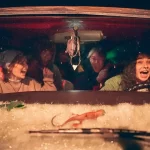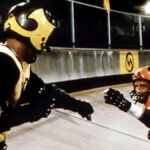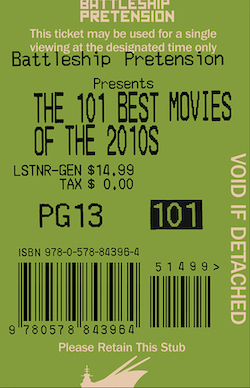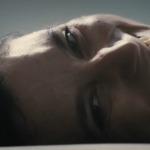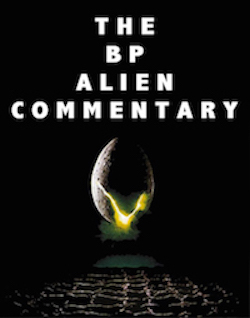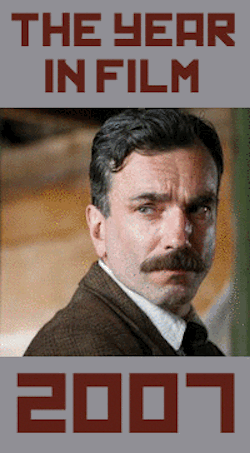Ebertfest 2013 Day Four, by Aaron Pinkston
After two long days and an earlier start for the fourth day of the 2013 Roger Ebert Film Festival, Tilda Swinton had a plan. By this point, I’m sure you’ve read about the events or seen the video but there probably wasn’t anything like being there. Unexpectedly, just before the start time for the day’s first film, Chaz came out with an announcement: that everyone needed to get on their feet and dance with Tilda. At first it seemed silly (and, OK, it kinda was), but as soon as Barry White began blasting over the speakers and Tilda started running through the crowd, there was definitely something infectious about it all. Ebertfest is one of the few places where something like this can go down without any cynicism or hesitancy coming from the crowd and that’s partly what makes this event so spectacular. The Ebertfest audience approaches their impromptu dance parties like they do their films, willing to have a little faith and go along for the ride.
Onto the first official proceedings on day four of Ebertfest, Blancanieves. The festival has typically had a silent film among the schedule, usually a larger-than-life epic of the silent screen with live accompaniment from the famed Alloy Orchestra — last year included a series of shorts from Georges Méliès — but this year’s selection was a bit different. Being a modern film with its own particular soundtrack that meant no Alloy Orchestra, which was a bit of a bummer as they were definitely a highlight of last year’s festival. Still, we were treated to a fun film, one with more modern sensibilities that would perhaps be a little easier for much of the audience to take.
Blancanieves is a clever translation of the Snow White tale which omits many of the fantastical elements while keeping the magic. A lot of the story elements are there (wicked stepmother, a group of dwarves) but writer-director Pablo Berger doesn’t take any of them at face-value, playing with the viewer’s expectations of Snow White and interjecting his own time and space. For example, there might not be a mirror on the wall, but the wicked stepmother is absolutely evil in a real-world kind of way. Like the best children’s tales, Blancanieves is dark and deeply scary — it absolutely succeeds as a retelling of the classic Grimm fairy tale.
With the critical success of The Artist and Tabu, silent films seem to be making a bit of a comeback, at least from European filmmakers. Compared to these other two films, Blancanieves feels more classical, truer to the silent era, with fewer obvious modern technique (strangely enough, it is also the only film of the three that is completely a silent film). Blancanieves probably isn’t a story that absolutely needs to be told as a silent film, but the the melodramatic tone of the emotional moments may work because of it. The silent nature of the film allows Berger to show his creativity through the imposed limitations and it all adds to the fairy tale environment and magical tone of the piece.
The second film of the day, Vikram Gandhi’s documentary Kumaré, was one of the three films I had previously seen, though this one in less-than-ideal circumstances. It’s a breezy sort of comedic doc that isn’t totally out of place to watch on a laptop in a crowded Starbucks, but seeing it on the big screen without distractions allowed me to dive into the film’s more-complicated-than-at-first-glance themes. The film is set-up like a Sasha Baron Cohen mockumentary, with filmmaker Vikram Gandhi exploring the boom of yoga and Eastern philosophy in American culture by becoming a guru to see if he could find a group of people to follow him. Initially interested in profiling American gurus, after seeing how many of them were no more spiritual or all-knowing than the people they led, Vikram decided to shift gears and become Kumaré. He creates a philosophy, a number of odd yoga moves, and heads to the sprawling metropolis of Phoenix, Arizona. There, he meets a number of people in search of something missing in their lives — a group dealing with issues of loss, health and happiness hoping to turn to Kumaré for some wisdom that will change their lives for the better.
Where Kumaré differs from Borat, though, is the film’s intent — Vikram’s character isn’t necessarily staged in order to poke fun at people, though he is certainly tricking them into believing something that is not really happening. Instead, the film is more transparently about the transformation of the filmmaker and the most interesting takeaway is how Vikram is affected by the events much more than those who end up following Kumaré. Not to give anything away, but the film also ends with Kumaré’s unveiling, a tense scene that nicely works with the moral questions that any viewer will have.
If you are tricking people, but end up helping them find themselves, is that immoral or harmful? It’s a complicated question that Kumaré realizes and obviously can’t fully answer. The question is made more interesting through Kumaré’s philosophy, which is literally that you don’t need a guru to be happy — throughout his teachings, he is constantly telling his students that reality is an illusion, through riddles that he literally isn’t who he says he is. By never really being dishonest and completely fulfilling the main tenant of his philosophy, has Vikram skirted around the morally gray area? Ultimately, the film shows how much Vikram has learned from his experience and while he is the center of the film, it never really absolves what he has done. At the end of the film, one of Kumaré’s students says something to the effect of approving of the teaching, but skeptical of the methods — a conclusion that I find myself falling on, as well. If you have any interest in religious philosophy or specifically yoga, Kumaré is a film to watch. If you are just looking for an entertaining, often funny documentary, it works well there, too.
The final two films I was able to see at Ebertfest this year were both 2013 Sundance hits, so being programmed together felt pretty special. Escape from Tomorrow was absolutely my most anticipated film going into the festival, for the obvious reasons. The most talked about film at Sundance because of its peculiar production, mostly being shot covertly at Disney World, it’s a film I may not have another chance of seeing. I was even anticipating it despite not having high expectations for the actual film. After seeing it, there is no doubt it was the most mixed reaction to a film at the festival — Escape from Tomorrow isn’t quite cut for the Ebertfest crowd — and probably the film I’m most undecided on.
To me, Escape from Tomorrow is definitely more interesting because of its production than for its results. Though the film has a number of shockingly funny moments and sets up rich thematic ground in the first half, it all falls apart in the last act. On the positive side, Escape from Tomorrow nimbly portrays both the good and the bad of the Disney experience — just how magical it can seem through the eyes of a child and how dirty, gross, unappealing it can be for an adult. The Disney-ness of the film really hits you in the first few scenes when you still haven’t gotten over the incredible fact of how this movie was shot. To director Randy Moore’s credit, by the end of the film, the setting settles in without being too distracting — at some point, you can just accept that this movie takes place at Disney and are able to forget the production background.
The very basic plot elements of the story involve a typical family of four (father, mother, young son, young daughter) who are on a family vacation at the “happiest place on Earth.” The family’s patriarch (and ostensibly the film’s central character), played by Ebertfest guest Roy Abramsohn, is a young father who probably shouldn’t be a father — in the least, he’s not quite sure himself. Though he obviously loves his family, he seems to be longing for his youth, and what better place to be for that than Disney World? Though I don’t have personal experience, being a parent at Disney must be pretty frightening. First off, though there are adult attractions, you have to wholly cater to what your kids want. More importantly, you are in a crowded area with a number of strangers who could tempt or corrupt your children in a number of ways. Escape from Tomorrow does a wonderful job of displaying all the potential horrors of this experience, magnified through a character easy to judge as an irresponsible parent. At its best, it’s one of the best film examples exploring the themes of young parenting.
After a pretty satisfying first half, Escape from Tomorrow quickly and unexpectedly becomes something else. The film’s tone and narrative change in a way that I would have thought was excellently cool at a younger age, fitting with the film’s overall juvenile mentality. I won’t get into any specifics in fear of spoilers, but the shifts go all over the place to the point where I’m not quite sure if the film knows what it is trying to do. Whereas the opening felt so surely and strongly directed (especially given the unique production), the ending is an exemplar of half-baked.
Part two of “Sundance in Champaign,” The Spectacular Now, may have come out of the same festival as Escape from Tomorrow, but it couldn’t be different in tone, look and feel. Featuring an established director (James Ponsoldt, whose Smashed is definitely worth checking out) and an up-and-coming cast including Miles Teller (Rabbit Hole) and Shailene Woodley (The Descendants), it’s the type of mid-budget dramedy that has become a Sundance cliche — don’t let that perception stop you from seeing The Spectacular Now when it reaches theaters later this year.
Teller stars as Sutter Keely, a well-liked high school senior who isn’t exactly looking toward the future. Sutter is a throwback high school character, part Lloyd Dobler part Ferris Bueller, who is popular without being a jock or a jerk. While watching the film I was definitely struck by Teller, who exudes a likeable confidence akin to a young John Cusack — I thought I was being clever with this comparison until a Q&A participant made a similar comment and then I realized that Ebert made the connection in his write-up on the film.
After Sutter is dumped by his equally liked girlfriend (Brie Larson), he meets Aimee Finicky (Woodley), a quiet, unassuming girl. If I give the film credit of making Sutter a popular kid without making him a jerk, I guess I should give the film some credit of giving Aimee nerdy tendencies without making her a complete outcast. Their budding relationship seems strange to some others, but isn’t met with the resistance we often see in teen romance dramas where beautiful people “of different worlds” shouldn’t be together. When we see the two characters together it all totally makes sense, the outgoing Sutter and the sharp Aimee are a great match with chemistry and compatibility. The two actors have surprising chemistry, both being so young — their first kiss is a beautifully staged and acted scene and will no doubt end up as one of my favorite scenes of the year.
To add more drama to the dramedy, The Spectacular Now deals with two important and converging issues with Sutter — his casual alcoholism and the reconnection with his father, who left their family when Sutter was very young. Both of these plotlines are dealt with seriously and surprisingly, especially the presence of alcoholism. The film never minimizes Sutter’s problem, but it also doesn’t push it onto you, a delicate and difficult balance. We see Sutter drinking in most every scene, hidden through flasks and Big Gulps. Because he is functional (there aren’t many, if any, big emotional scenes where Sutter’s alcoholism rears its head sparking an epiphany) and cool, it would have been really easy to glorify the problem. Just think of two other films starring Miles Teller, Project X and 21 and Over, both which are similar coming-of-age tales, but films where underage (or barely of-aged) drinking is absolutely acceptable. The Spectacular Now beautifully and subtly shows the signs of where Sutter is headed if he doesn’t change his life. By the end, we don’t know if Sutter has gotten better, but it seems as if he’s prepared to take the first steps. In this way, The Spectacular Now isn’t a message movie, just a really good one.
There was one final day of Ebertfest, but I was unfortunately not able to stay to see the closing film, Not Yet Begun to Fight. From what I’ve heard, it is a fantastic documentary worth seeking out.
The 2013 Roger Ebert Film Festival was an absolute success — joyous, emotional, triumphant and lots of fun. I’ve said it before and I’ll say it again, if you have any opportunity to attend a future festival, I urge you to do so. You won’t get a more inclusive film experience than at Ebertfest — from the receptiveness of the audience, to the makeshift, but whole community created over the five days. I’m not sure what Ebertfest is going to look like over the next few years, but it’ll undoubtedly will be different — that doesn’t mean it will be markedly worse. I’ll leave you with something for film lovers to look forward to: at a point during the festival, Chaz mentioned that the festival is going to more actively look for films to project on 35mm and 70mm. Hooray for film!



